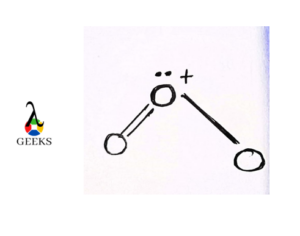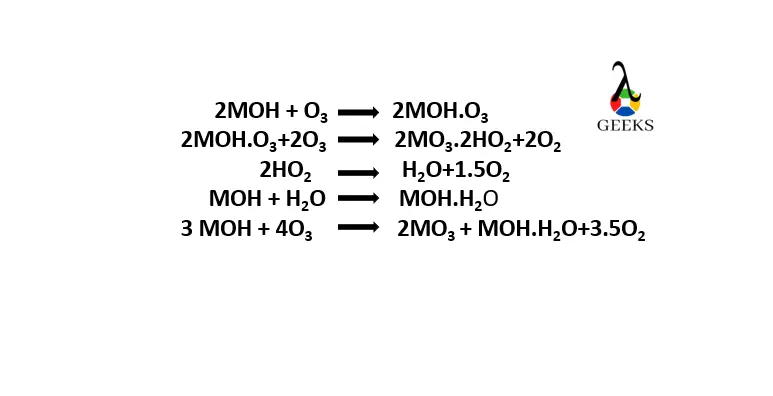Ozone plays an important role for the existence of life as it absorbs most of the UV radiation of the sun. Let us jump into the discussion of the different properties of O3.
Ozone has a bent structure with c2v symmetry. Here the central atom undergoes sp2 hybridization with one lone pair of electrons, and the O – O – O angle is 116. 78°.The central metal atom is sp² hybridized with one lone pair.
Here we will discuss ozone IUPAC name, molar mass, color , viscosity, melting point, and boiling point.
Ozone IUPAC name
The IUPAC NAME (International Union of Pure and Applied Chemistry) is Trioxygen.
Ozone chemical formula
Ozone has the chemical formula O3.
Ozone CAS number
Ozone has the CAS registry number (authentic numeric identifier which can contain upto10 digits)10028-15-6.
Ozone ChemSpider ID
Ozone has the ChemSpider ID (ChemSpider is a free chemical structure database) 23208.
Ozone chemical classification
- Ozone is an inorganic molecule, and it is a powerful oxidizing agent.
- Ozone has many applications related to industrial and consumer supplication oxidation.
Ozone molar mass
The Mass of 1 mole of ozone is 48 g.
Ozone color
Ozone is a pale blue color gas that condenses to dark blue liquid at a range of -1500 C to -2730 C and finally as a violet-black solid.
Ozone viscosity
- Pure liquid ozone viscosity at —183.0°C is 1.56±0.2 centipoises.
- Supercooled liquid ozone viscosity at —195.6°C is 4.14±0.5 centipoises.
Ozone molar density
The molar density of ozone is 2.144g/L.
Ozone melting point
Ozone has a melting point of -192.20 C.
Ozone boiling point
The ozone boiling point is -1120C.
Ozone state at room temperature
At room temperature, the molecular ozone exists in the gaseous state.
Ozone covalent bond
The Ozone is covalent in nature, as it is formed by sharing electrons between atoms.
Ozone covalent radius
The Covalent radii of oxygen in ozone are 0.73 Å.
Ozone electron configurations
The arrangement of electrons into the atomic orbitals of an element is called electronic configuration. Let us see the electronic configuration of O3.
Ozone has only one central atom, which is the oxygen atom. So, its outermost electronic configuration is 1s2 2s2 2P4.
Ozone oxidation state
Ozone has a zero-oxidation state. Because the three oxygen atoms bear charges 0, -1, and +1, so net charge becomes zero.
Ozone acidity/alkaline
Ozone exhibits acidic properties in the solution phase.
Is ozone odorless
Ozone has a pungent smell. Its’ odor is implicative of chlorine bleach, and it is discernible by many individuals at a concentration of0.1ppm in air.
Is Ozone paramagnetic?
Para magnetic character is exhibited by those atoms or molecules having unpaired electrons in their valency shell. Let us discuss whether ozone is paramagnetic or diamagnetic.
Sulfur hexafluoride is diamagnetic because it contains paired electrons in the outermost orbital.
Ozone hydrates
Ozone is unstable so it can be preserved in hydrate form .It can be done by using an ozone and oxygen gas mixture existing with carbon tetrachloride.
Ozone crystal structure
Ozone possesses a orthorhombic crystal structure. The space group of the ozone is C2V having dimensions The lattice parameters at 5 K are: a=778.88 pm, b=669.73pm, c=684.13 pm.

Ozone polarity and conductivity
- Ozone is a polar molecule because its dipole moment is 0.53 D.
- The electrical conductivity of ozone is in the range of 5 to 50MHz.
Ozone reaction with acid
Ozone can react with acids to form water, oxygen, and carbon dioxide as products.
CH2C (CH3) COOH + 9 O3 —- > 4 CO2 + 3 H20 + 9 O2
Ozone reaction with base
Ozone reacts with NaOH to form sodium ozonide with a high yield percentage.

Ozone reaction with oxide
Ozone can react with oxides like SO2 and MgO to form oxygen.
SO2 + O3 → SO3+ O2
MgO + O3 → MgO2+ O2
Ozone reaction with the metal
Ozone can react with metals to form the oxides of the metals to the highest oxidation state.
Cu + O3 → CuO + O2
Ag + O3 → AgO + O2
Conclusion
The role of ozone is very crucial. It has vast applications, like in agriculture and aquaculture, and is used as a medication for treatment.

Hi…I am Surya Satya Eluri. I have done my M.Sc in Organic Chemistry. I am very enthusiastic about the high-energy chemistry field. I love to write complicated chemistry concepts in understandable and simple words.
Let’s connect through LinkedIn: